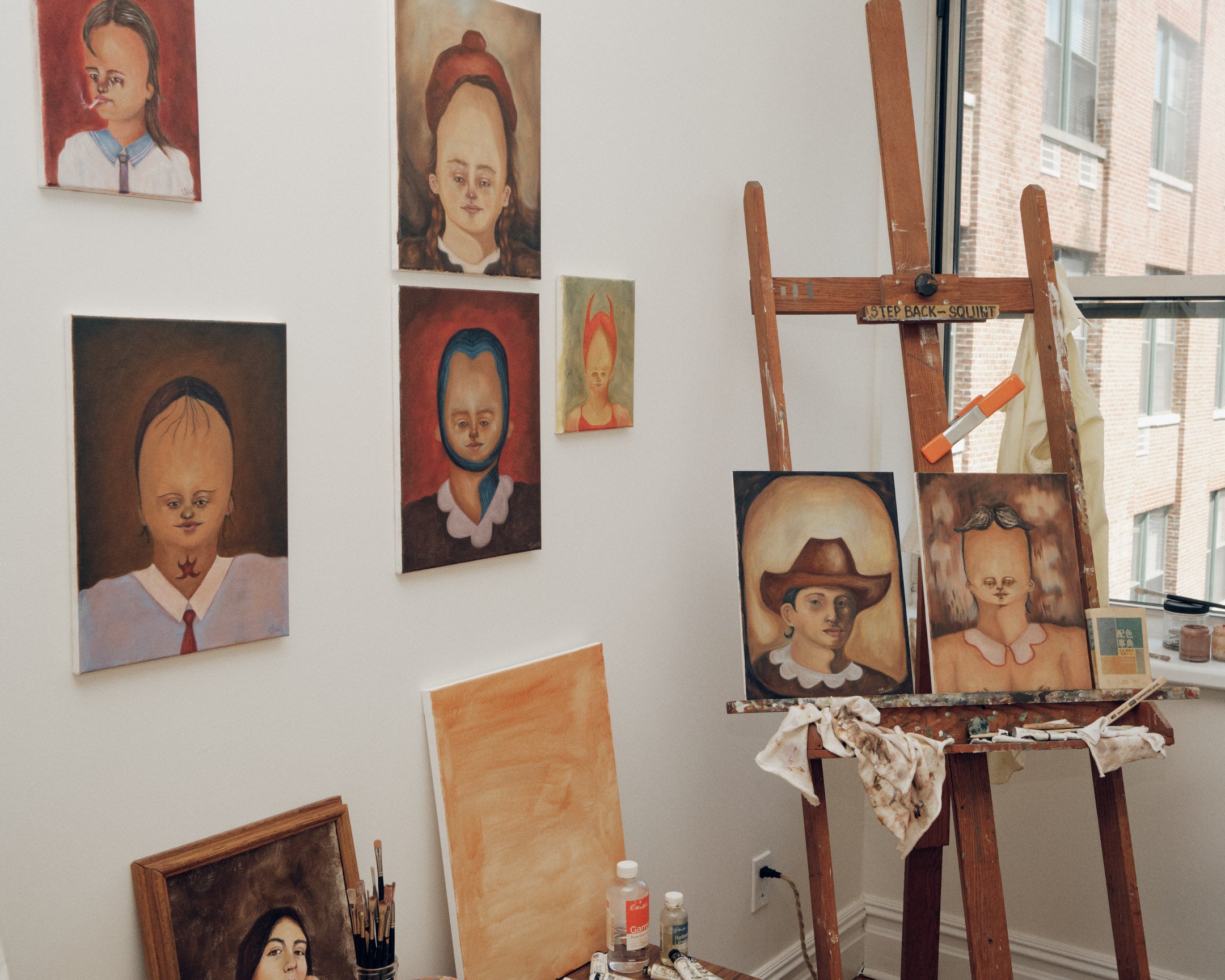Say the world wants to make you useful. It breaks you into pieces: manageable, nameable, sharp-optimized. So, we march fractured but productive. But somewhere in Brooklyn, a woman is collecting her pieces, fitting them together where they belong and polishing the ones that don’t. Natasha Jiwa sits in the soft belly of her studio, light pooling at her feet like a second canvas. Outside, the city performs its ritual of noise. She doesn’t look up. Instead, she paints the faces that find her. Not muses, not inventions, more like memories arriving early. The brush moves slowly. The room listens. Time thickens to honey. Softness, here, is not a weakness but a way through. The opposite of collapse, it’s a survival dotted with color.

“Being soft is so important to me,” she says. “The urgency of that message has always been present. Now, it’s getting scary. Softness feels harder to hold onto in our world.”
In her Brooklyn home studio, Jiwa moves fluidly between digital design, hand-drawing, and most recently, oil painting. Her practice, like her identity, has never been static. What began in marketing, shifted into graphic design, then into illustration, and now rests somewhere in the quiet mess of figure studies and imaginative portraits. “I’ve always wanted to paint,” she says. “But I wasn’t traditionally trained. Becoming a painter let me explore new parts of myself and rediscover old ones. I’m still surprised when a piece comes together.”

Much of Jiwa’s recent work centers on faces that arrive like visitors from a gentler planet. Elongated and tender, they peer out from backgrounds of rust and amber, navy and cream, sometimes skewed just slightly to one side, as if painted through water or memory.
“Most of my paintings start as sketches of these faces that just kind of appear in my head,” she explains. “They’ve got little personalities.”

“They aren’t portraits of anyone, but they seem to carry traces of everyone. Something like a face glimpsed in a dream, softened at the edges. Some wear head coverings that bloom like flowers. Others sport collared shirts that suggest schol photos from dreams. There’s something both ancient and childlike about them, innocent yet wise, as if they carry secrets they’re too kind to tell. They cluster together on her studio wall like a congregation of the tender-hearted, each one a small argument for the beauty of the unfinished, the slightly askew, the perfectly imperfect human face.

When she talks about her process, there's no forced search for meaning. No pressure to define the work or explain it away. "What feels essential to making work that's true to who I am? Not thinking about the meaning of it. Just letting it come through."
This refusal to intellectualize runs deeper than artistic choice. The world has become a place where everything must justify itself, where even sleep needs to be tracked, where creativity gets reduced to content. Artists are expected to articulate their "dialogue with art history," to package their intuition into sellable insights. Against this relentless accounting, Jiwa's work feels like an act of rebellion. She paints because faces appear in her head. She takes time because time asks to be taken.

There's something radical in this refusal, something necessary. Each painting becomes a small protest against the idea that everything worth doing must also be worth selling. Her faces don't perform or persuade. They simply exist, slightly crooked and entirely themselves. In a culture that insists we optimize our way to happiness, she offers something different: the wild possibility that we might already be enough, exactly as we are, in our own imperfect time.

Even her environment echoes that presence. “I recently moved into my new home studio and realized most of my neighbors are musicians. Some days I’ll hear a saxophone wailing into the sky, other nights it’s someone on guitar. I let the sounds float up to my space and it helps me stay grounded. I remember I’m just a tiny dot on this earth. I try not to take things so seriously.”

That sentiment threads through everything, this refusal to posture or perform. Her queerness, too, isn’t something to be announced. It simply is. “Queerness has almost always been undeniable to my identity,” she says. “What’s shifted more over time is how I relate to my race and culture. That’s what’s pushed me to accept myself more fully.”

Right now, being in her own time means letting go of shame. It means getting it wrong sometimes. And showing up anyway. “I’m growing more into myself and my process, my mistakes and imperfection. I’m leaving behind shame.”
When asked what she’s most proud of, she doesn’t name a painting or a milestone. Just this:“That I create anything at all.”
Images by Roger Gallegos.












